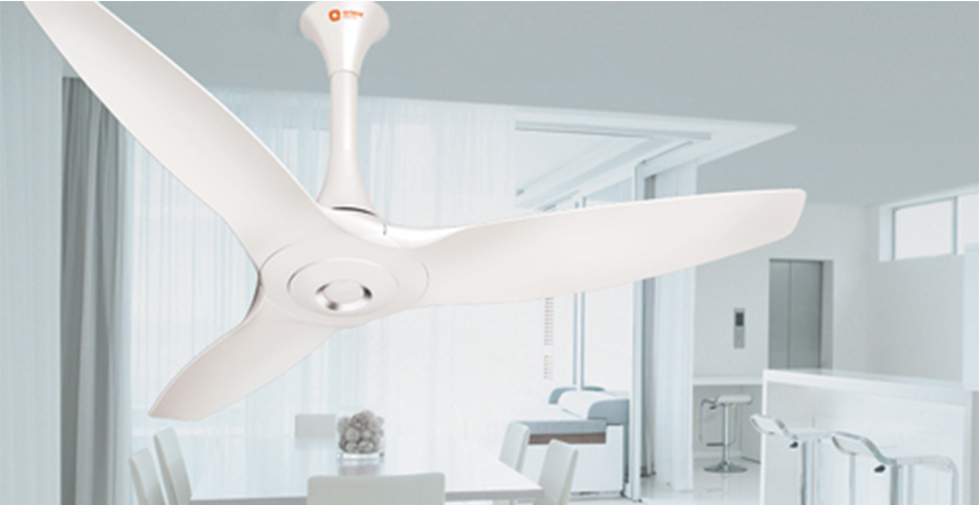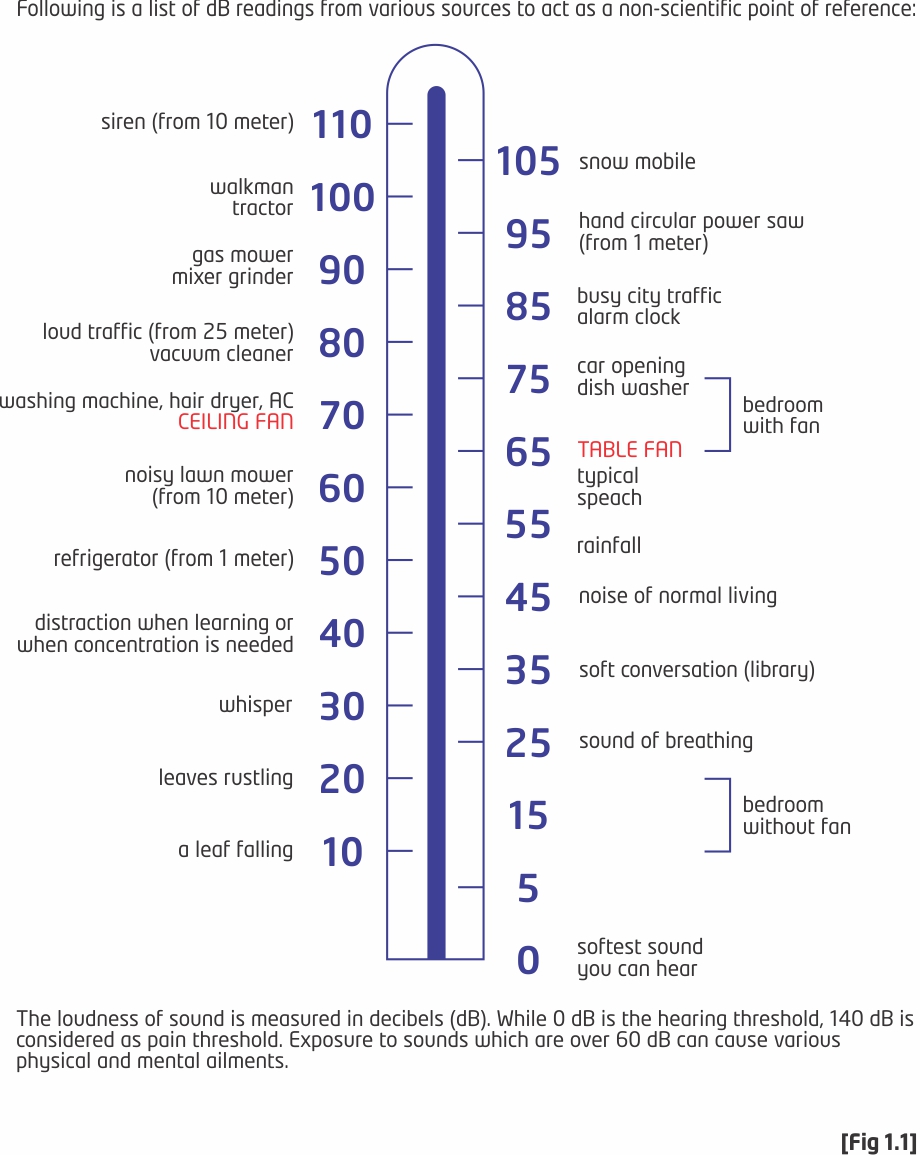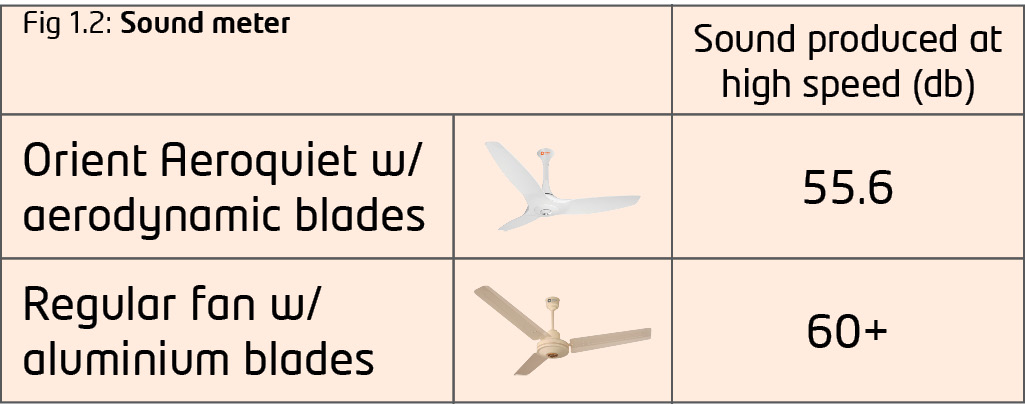- categories:
- Fans
- Home Appliances
- Lighting
If you think fans have got to be noisy, think again!

We live in an environment where we are exposed to different types of sounds on a daily basis. While these sounds have become a part of our life and hardly bother us much, it is important to understand that regular exposure to higher sound levels can lead to serious health consequences. Some of the widely known health effects of noise pollution include headaches, stress, sleeping disorders and hypertension. Noise Meter

 The most common causes of noise pollution are transportation systems, industrial equipment etc. However, one should not ignore the common sounds we are exposed to inside our homes which are caused by the routine use of home appliances such as TV, vacuum cleaner and ceiling fans among others. To paint a better picture, let’s first have a look at loudness (decibel levels) of common sounds [Ref. Fig 1.1].
The most common causes of noise pollution are transportation systems, industrial equipment etc. However, one should not ignore the common sounds we are exposed to inside our homes which are caused by the routine use of home appliances such as TV, vacuum cleaner and ceiling fans among others. To paint a better picture, let’s first have a look at loudness (decibel levels) of common sounds [Ref. Fig 1.1].
India being a big tropical country, ceiling fans are a common household sighting and they run for 8-10 hours during the summer season and in fact up to 10 months in a year. Putting this in other words, we are exposed to the fan noise for long hours in our day-to-day lives. It won’t be an understatement to say that fan noise has become a part of our lifestyle and we have reluctantly accepted this problem.
Doesn’t the air cutting noise of our fan bother us while talking on our phones? Doesn’t the fan noise disturb our TV watching experience? The answer is “It does” but we tend to ignore it.
The main reason of fan noise is in fact the sound of air cutting which is produced when blades of a fan cut the air to create turbulence causing air to be pushed. Other factors that contribute to the fan noise including the size and quality of motor, design of blades, mounting hardware and the body material. While the tick-tick noise or the grumbling noise of the motor is contributed by mechanical defects and can be rectified, there has not been much of work done to reduce the air cutting sound of a fan which we feel is a “performance driven sound”.
While ‘noise pollution’ from a ceiling fan does not bring to mind the thought of life-threatening diseases, but it does interfere with our body’s rhythm and affect our overall health and well-being. As you may see in the Fig 1.1, ceiling fans on an average generate between 60dB to 70dB of loudness which has been suggested as good enough noise by many studies. In many parts of India, people use a ceiling fan alongside an air conditioner. Now imagine sleeping in a room for 8-10 hours daily which has both a ceiling fan and an air conditioner (60-70dB sound level) running at the same time. Now, you are exposed to two sounds that generate almost same amount of loudness, thereby doubling the overall noise effect. If you are using ceiling fan and AC simultaneously during the day inside your home or office, add in other unpleasant sounds like those of traffic and electrical/electronic devices which could collectively lead to negative health effects.
The latent need for a noiseless fan
Now when we know that ceiling fans do contribute to an extent to noise pollution, it makes sense to check the sound level when buying a ceiling fan. But then, there are no such established rules or regulations for the Indian fan manufacturers to meet or publish any sound level standards. That’s the reason why this subject has rarely been talked about by the manufacturers as well as consumers.
Having said that, Orient Electric has for the first time introduced a breakthrough in fans by addressing the important though latent need for silence. It has recently launched the new Aeroquiet premium ceiling fan which promises highest ever air flow with heavenly silence. table

A report by independent international lab “Jost” confirms that Aeroquiet makes 4dbs lesser noise than other fans [Ref Fig 1.2]. To explain it further, noise level reduces by 1000 times per DB which means that Aeroquiet reduces noise by 4000 times in comparison to normal fans.
The silent fan features advanced aerodynamic profiled blade design which ensures maximum air throw while reducing sound by reducing friction and turbulence. It also has the sturdiest 18-pole heavy motor with double ball bearing for smooth and silent operation. Orient Aeroquiet runs at 310 RMP and has an impressive air delivery of 240 CMM which is highest in the segment. Moreover, the fluidic integrated design of Orient Aeroquiet makes it an innovatively beautiful choice for the fifth wall in your home.
comments 0


Customer Support
Orient Electric products are available near you. Visit our store locator to find the nearest store.
You can also reach out to us directly in case you need assistance in purchasing our products or regarding any service-related query.
Mail us at customer.connect@orientelectric.com or call 18001037574
Store locator


 Connect
Connect
